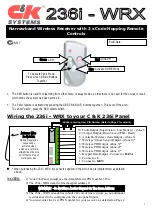
Page 26
RF65
Tel: +86-755-82973805 Fax: +86-755-82973550 E-mail: [email protected] http://www.hoperf.com
ADVANCED COMMUNICATIONS & SENSING
DATASHEET
3.4.14. Bit Synchronizer
The Bit Synchronizer is a block that provides a clean and synchronized digital output, free of glitches. Its output is made
available on pin DIO1/DCLK in Continuous mode and can be disabled through register settings. However, for optimum
receiver performance its use when running Continuous mode is strongly advised.
The Bit Synchronizer is automatically activated in Packet mode. Its bit rate is controlled by
BitRateMsb
and
BitRateLsb
in
RegBitrate.
Raw demodulator
output
(FSK or OOK)
BitSync Output To
pin DATA and
DCLK in continuous
mode
DATA
DCLK
Figure 10. Bit Synchronizer Description
To ensure correct operation of the Bit Synchronizer, the following conditions have to be satisfied:
A preamble (0x55 or 0xAA) of 12 bits is required for synchronization (from the
RxReady
interrupt)
The subsequent payload bit stream must have at least one transition form '0' to '1' or '1' to '0 every 16 bits during data
transmission
The bit rate matching between the transmitter and the receiver must be better than 6.5 %.
Notes - If the Bit Rates of Transmitter and Receiver are known to be the same, the RF65 will be able to receive an
infinite unbalanced sequence (all
“0s” or all ”1s”) with no restriction.
- If there is a difference in Bit Rate between Tx and Rx, the amount of adjacent bits at the same level that the
BitSync can withstand can be estimated as follows:
- This implies approximately 6 consecutive unbalanced bytes when the Bit Rate precision is 1%, which is easily
achievable (crystal tolerance is in the range of 50 to 100 ppm).
3.4.15. Frequency Error Indicator
This function provides information about the frequency error of the local oscillator (LO) compared with the carrier frequency
of a modulated signal at the input of the receiver. When the FEI block is launched, the frequency error is measured and the
















































